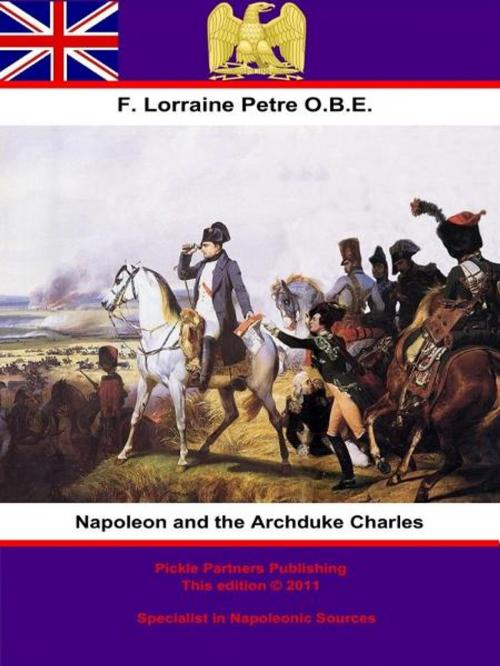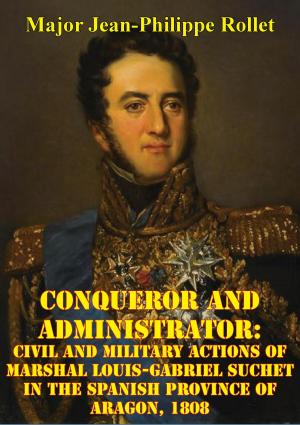| Author: | Francis Loraine Petre O.B.E | ISBN: | 9781908692801 |
| Publisher: | Wagram Press | Publication: | July 5, 2011 |
| Imprint: | Wagram Press | Language: | English |
| Author: | Francis Loraine Petre O.B.E |
| ISBN: | 9781908692801 |
| Publisher: | Wagram Press |
| Publication: | July 5, 2011 |
| Imprint: | Wagram Press |
| Language: | English |
“The campaign which forms the subject of this volume is one which has received scant notice in England, and has been a good deal misunderstood. The misunderstanding has been mainly due to Napoleon's successful misrepresentation of the earlier part as one of his greatest and most successful efforts.”
So begins Petre’s excellent study of the 1809 campaign in Germany, the most concise study of one of the most interesting of Napoleon’s campaigns.
The peace of Tilsit in 1807 was the Apogee of Napoleon’s reign, he had subdued all of his continental enemies; Prussia a broken wreck after Jena-Auerstädt, Austria smashed at Austerlitz, Russia humbled after Friedland. However the new allies of the French smarted from the reduction of territory, prestige and glory, they were also being squeezed by the constraints of commerce embodied by the Continental system whereby Britain and her products were meant to be kept out of mainland Europe. They looked only for a sufficient time to re-gather their forces, bide their time and strike to take back what was formerly theirs, as the peace creaked and groaned under the pressure, Napoleon decided to dethrone the Spanish Bourbons in 1808. The Peninsular war would grow into a painful “ulcer” for the French and after set backs such as the disaster of Baylen, where an entire French army corps surrendered to the Spanish, and Vimiero where the French were kicked out of Portugal, the continent took heart and prepared to strike at Napoleon.
The Austrians were to take up the challenge in 1809, under the leadership of the Archduke Charles, the Emperor’s younger brother. He had spent some time modernising the army after the defeats of 1805, and although advising against the timing of the war he stood ready to take charge.
Napoleon gathered his forces quickly, boosted in numbers by German allies, and advised his lieutenants in the theatre what to prepare. However his orders were misinterpreted and when put into action the French forces were scattered and in danger of being overwhelmed piece-meal. However Napoleon managed to salvage the situation, and despite a growing number of mistakes, and some sterling fighting on the part of Davout, pushed the advancing Austrians from Bavaria. The road to Vienna was thus opened for him, but he would have to first cross the Danube and pass to the Marchfeld to take on his most able continental opponent. The battles of Aspern-Essling and Wagram were to follow, leaving Napoleon beaten off the field of battle for the first time in a major engagement, as the decline in his “star” starts.
A great read, by a master historian.
Author – Francis Loraine Petre OBE - (1852–1925)
“The campaign which forms the subject of this volume is one which has received scant notice in England, and has been a good deal misunderstood. The misunderstanding has been mainly due to Napoleon's successful misrepresentation of the earlier part as one of his greatest and most successful efforts.”
So begins Petre’s excellent study of the 1809 campaign in Germany, the most concise study of one of the most interesting of Napoleon’s campaigns.
The peace of Tilsit in 1807 was the Apogee of Napoleon’s reign, he had subdued all of his continental enemies; Prussia a broken wreck after Jena-Auerstädt, Austria smashed at Austerlitz, Russia humbled after Friedland. However the new allies of the French smarted from the reduction of territory, prestige and glory, they were also being squeezed by the constraints of commerce embodied by the Continental system whereby Britain and her products were meant to be kept out of mainland Europe. They looked only for a sufficient time to re-gather their forces, bide their time and strike to take back what was formerly theirs, as the peace creaked and groaned under the pressure, Napoleon decided to dethrone the Spanish Bourbons in 1808. The Peninsular war would grow into a painful “ulcer” for the French and after set backs such as the disaster of Baylen, where an entire French army corps surrendered to the Spanish, and Vimiero where the French were kicked out of Portugal, the continent took heart and prepared to strike at Napoleon.
The Austrians were to take up the challenge in 1809, under the leadership of the Archduke Charles, the Emperor’s younger brother. He had spent some time modernising the army after the defeats of 1805, and although advising against the timing of the war he stood ready to take charge.
Napoleon gathered his forces quickly, boosted in numbers by German allies, and advised his lieutenants in the theatre what to prepare. However his orders were misinterpreted and when put into action the French forces were scattered and in danger of being overwhelmed piece-meal. However Napoleon managed to salvage the situation, and despite a growing number of mistakes, and some sterling fighting on the part of Davout, pushed the advancing Austrians from Bavaria. The road to Vienna was thus opened for him, but he would have to first cross the Danube and pass to the Marchfeld to take on his most able continental opponent. The battles of Aspern-Essling and Wagram were to follow, leaving Napoleon beaten off the field of battle for the first time in a major engagement, as the decline in his “star” starts.
A great read, by a master historian.
Author – Francis Loraine Petre OBE - (1852–1925)




![Cover of the book History Of The Consulate And The Empire Of France Under Napoleon Vol. VIII [Illustrated Edition] by Francis Loraine Petre O.B.E](https://www.kuoky.com/images/2016/march/300x300/9781786259158-mnIb_300x.jpg)










